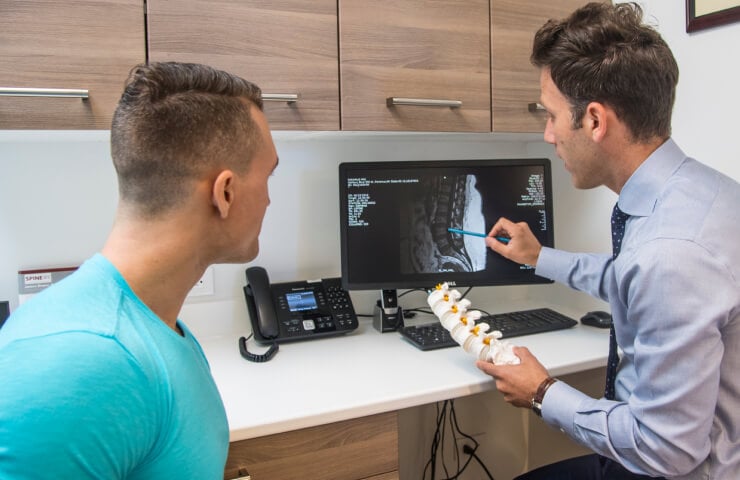Hand, Wrist, and Elbow Conditions
Together, your hand, wrist, and elbow form the most dynamic components of your lower arm that allow you to lift and move objects. The elbow is the joint where the bones of the forearm meet the bone of the upper arm. The wrist is a highly complex joint that actually consists of multiple joints and bones connecting the forearm to the hand. Our hands, which are uniquely adapted to a wide range of manipulations and movements, also consist of several bones and joints to allow for dynamic flexibility.
Because we use our elbows, wrists, and hands for nearly every activity, these three parts of the body are highly susceptible to pain due to injuries and general usage. Hand, wrist, and elbow pain can range from minor to severe.
We Specialize in Treating
Carpal Tunnel Syndrome
De Quervain’s Tenosynovitis
Ganglion Cyst
Golfer’s Elbow/Tennis Elbow
Trigger Finger
All Hand, Wrist & Elbow Conditions
- Biceps Tendonitis
- Carpal Tunnel Syndrome
- Cubital Tunnel Syndrome (Ulnar Neuropathy)
- De Quervain’s Tenosynovitis
- Diabetic Neuropathy
- Dislocated Elbow
- Dislocated Finger
- Dislocated Wrist
- Dupuytren’s Contracture
- Elbow Arthritis
- Elbow Bursitis
- Elbow Fracture
- Elbow Pain/Injury
- Elbow Sprain/Strain
- Elbow Spurs
- Elbow Tendonitis
- Extensor Tendon Injury
- Finger Dislocation
- Finger Sprain
- Flexor Tendon Injury
- Ganglion Cyst
- Golfer’s Elbow/Tennis Elbow
- Hand Arthritis
- Hand Fracture
- Hand Nerve Injury
- Hand Pain/Injury
- Hand Sprain/Strain
- Mallet Finger
- Muscle Trigger Points
- Olecranon Bursitis
- Osteochondritis Dissecans
- Pitcher's Elbow (Medial Apophysitis)
- Ruptured Bicep Tendon
- Sports Injuries
- TFCC Tear
- Triceps Tendonitis
- Trigger Finger
- Ulnar Collateral Ligament (UCL) Tear
- Ulnar Neuropathy
- Wrist Arthritis
- Wrist Fracture (Broken Wrist)
- Wrist Pain/Injury
- Wrist Sprain/Strain
- Wrist Tendon Injury
- Wrist Tendonitis
Get Advanced Hand, Wrist & Elbow Care
Right In Your Neighborhood
Finding the treatment that’s right for your hand, wrist, or elbow problem is our focus at The Orthopedic Health Center. We use non-surgical treatments whenever possible. When you do need surgery, our expert surgeons help you heal faster and with less pain. All right in your neighborhood: Hoboken, Jersey City, or Bayonne.
Anatomy of the Hand, Wrist, and Elbow
The hand is one of the most dynamic parts of the body, consisting of two different types of bones: the phalanges and the metacarpals. There are 14 phalanges that make up the fingers. The thumb contains only two phalanges, while the rest of the fingers contain three. The different types of phalanges are separated into three segments:
- Distal phalanges, which comprise the fingertips
- Middle phalanges, which are located in the middle of the fingers except for the thumb
- Proximal phalanges, which are located above the knuckle
The hand also has five metacarpal bones located in the palm that connect the proximal phalanges to the bones of the wrist. Each metacarpal connects to one finger.
The wrist consists of eight bones, known as carpal bones, and three joints. These bones and their joints make it possible for you to move your hand back and forth and from side to side. The carpal bones connect to the radius and ulna, which are the two long bones located in your forearm, between your wrist and elbow. The three joints of the wrist are:
- The radiocarpal joint, which connects the radius with the first row of carpal bones
- The ulnocarpal joint, which connects the ulna to the wrist bones
- The distal radioulnar joint, which connects the radius and the ulna
The elbow is the hinged joint that connects the radius and ulna in the forearm with the humerus bone of the upper arm. The ends of each of these bones are covered in a rubbery tissue known as cartilage, which provides shock absorbance and allows bones to slide against each other with ease.
Tissues of the Hand, Wrist, and Elbow
The hands, wrists, and elbows are held together and supported by a number of muscles, as well as connective tissues (ligaments and tendons). The hand contains both intrinsic and extrinsic muscles. Intrinsic muscles are muscles that are located deep within the body, while extrinsic muscles are located closer to the surface. In hands, the intrinsic muscles are:
- The thenar muscles: three short muscles located at the base of the thumb
- The hypothenar muscles: four muscles located within the palm
- The interossei muscles: muscles located between the metacarpal bones
- The lumbrical muscles: another group of muscles located between the metacarpal bones
The ability of the wrist to move and rotate is powered by six primary muscles. Some muscles, such as the flexor carpi radialis and the flexor carpi ulnaris, originate in the anterior of the forearm and run down the length of the arm into the wrist. Some, like the palmaris longus muscle, help to facilitate and coordinate movement between the forearm and hands.
The elbow joint connects to several different muscles:
- Biceps brachii: a large muscle located in the upper arm that is primarily responsible for flexion in the arm
- Triceps brachii: a large muscle located in the posterior of the upper arm that supports arm extension and fine movement of the elbow
- Brachialis: a large muscle that is located below the bicep and is the primary muscle involved in elbow flexion
- Brachioradialis: a superficial muscle in the forearm that assists the elbow in flexion, straightening
- Pronator teres: a muscle located in the forearm that enables the arm to turn the palms of the hand backward
- Extensor carpi radialis brevis: a small muscle located in the forearm that facilitates extension and abduction of the wrist
- Extensor digitorum: a muscle located in the forearm that assists with the movement of the fingers
The hand, wrist, and elbow are all supported by several tendons and ligaments. Tendons are a type of connective tissue that attaches bones to muscles, while ligaments attach bones to each other. These tissues help to provide structural support and stability when in movement.
Hand, Wrist, and Elbow Pain FAQ
A: There are many conditions and injuries that can have a painful impact on the bones, joints, and connective tissues of the hand, wrist, and/or elbow. One of the most common causes of pain in the lower arm is arthritis, which is when inflammation occurs in the joints. Repetitive motions can also cause pain. Hands, wrists, and elbows can also be injured during high-impact activities such as sports.
A: In many cases, hand, wrist, and elbow pain may not be a cause for immediate concern. In some cases, you may be able to manage your pain at home. However, if the pain is severe, limits your movement, gets steadily worse, or doesn’t improve with treatment, schedule an appointment with an orthopedic doctor as soon as possible. This is especially important if your pain is accompanied by a visible deformity, difficulty carrying objects, swelling, redness, and/or numbness.
A: Pain in the hand, wrist, and elbow is sometimes caused by performing certain repetitive tasks. In these cases, alleviating your pain may be as simple as modifying these motions so that you’re not stressing the affected body part. Other at-home treatment techniques include over-the-counter pain relievers, wearing splints for stability, and ice/heat applications.
The Most Advanced Surgical Techniques
Take a closer look at the level of care to expect at The Orthopedic Health Center.
Edward Feliciano, MD
Director of Orthopedic Surgery
Edward Feliciano, MD is a board-certified orthopedic surgeon and the Director of Orthopedic Surgery with training from Yale, Cornell and Georgetown University.
Appointments available now.















